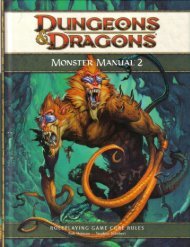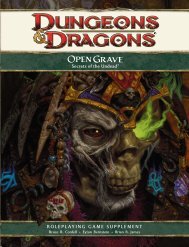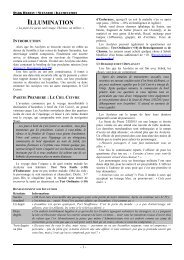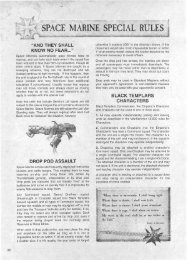Create successful ePaper yourself
Turn your PDF publications into a flip-book with our unique Google optimized e-Paper software.
most important—how to view the world around it.This awareness is one reason that even the youngest<strong>dragons</strong> are capable of surviving to adulthood. Itis also why a sense of superiority and arrogance isubiquitous among <strong>chromatic</strong> <strong>dragons</strong>: They are bornalready knowing that they’re among the most powerfulcreatures in the world (or at least will be, afterthey mature).Parents might accompany a wyrmling on its earliesthunts, to protect it and to make certain it knowshow to hunt efficiently. Wyrmlings left to fend forthemselves and wyrmlings that don’t have protectiveparents still must leave the nest within a few days ofhatching to find food. By the third or fourth foray,even solicitous dragon parents let wyrmlings hunt ontheir own, lest the wyrmlings grow too dependent onparental assistance.Wyrmlings spend a few years dwelling with oneor both of their parents. Some parents welcomethis time as an opportunity to teach their offspringlessons beyond its inherited knowledge: the bestareas to hunt, what to look for in a lair, how to beginbuilding a hoard, and other knowledge a growingdragon needs to gain. Other parents look on wyrmlingsas necessary evils: competitors for resourcesand for space in the lair that must nevertheless betolerated for a brief time. Only evil <strong>dragons</strong> thatlack any parenting instinct—in dragonkind, a mildform of insanity—consider forcing a wyrmling toleave the nest early. This condition is most commonin black and gray <strong>dragons</strong> but rare even amongthem.A wyrmling whose parents abandoned it before ithatched or could not care for it after it hatched takeslonger to hone its abilities. It still has the advantageof its inherited instincts, but the lack of a teachermakes perfecting its abilities an arduous task. Somewyrmlings manage to do so on their own, throughtrial and error. Others seek out mentors of their ownkind. Even an evil dragon might willingly take on ashort-term apprentice if the younger dragon showsadequate respect, such as gifts of treasure scavengedor stolen from any source the young dragoncan manage. These relationships rarely last morethan a few months, because the older dragon inevitablybegins to view the younger one as a rival. Theyounger dragon either departs or ends up on themenu.Although wyrmlings are small and weak bydragon standards, a wyrmling is roughly the sizeof a large wolf or a full-grown human. Even at theiryoungest, <strong>dragons</strong> have few natural predators. For fullstatistics on <strong>chromatic</strong> dragon wyrmlings, see pages179–186.YoungBy the time a wyrmling becomes a young dragon,it has grown to roughly the size of a horse, and itshoarding, lairing, and territorial instincts are stokedinto a raging fire. A young dragon must leave the nest(if it has not already done so) before territoriality andgreed transform the parent–child relationship into abitter rivalry.The relationship between a dragon and its fullgrownoffspring depends on the individuals inquestion. For the most part, dragon parents andchildren retain a loving relationship; though they donot share territories, they harbor affection for eachother and render assistance if the other is in danger.A rare few go the opposite route, treating their parentsor offspring as competitors for resources—highlydangerous competitors, since each knows the otherso well—and end up violently at odds. The majority of<strong>chromatic</strong> <strong>dragons</strong> fall between the two extremes: Avague fondness exists between parents and offspring,but neither is likely to jump into action if the otherneeds help. They react to any intrusion with as muchviolence as they would if the invader were a stranger.The first task of a young dragon is to find a lair ofits own. This task can prove challenging, because theterritory the dragon knows belongs to either a parentor a mentor. Thus, a young dragon must depart theregion it knows best to find a spot isolated enough toserve as a lair, yet still near enough to viable huntinggrounds to make foraging possible.Young <strong>dragons</strong> use existing structures (such asabandoned castles or mines) or natural hollows (suchas caves) for their lairs. Later in life, when a dragonhas more power, knowledge, and confidence, it mightbuild, or find others to build, a better home. At theyoung stage, though, it just needs to find somethingviable.A young dragon also starts to build its hoard. Dragonsof this age are likely to attack random travelersor caravans, scrounging whatever wealth they canacquire by using such an unsophisticated approach.As <strong>dragons</strong> grow older, they grow wiser and moreselective, but a young dragon just wants to start accumulatingtreasure.AdultAdult <strong>dragons</strong> revel in the fact that they are amongthe mightiest predators in existence, particularlyif they have had a successful youth. When seekingto add to their hoards, they are more selective intheir targets than younger wyrms, preferring notto waste their time with travelers or caravans thatlook unlikely to provide a decent amount of wealth—though they might still attack such groups for food orsport.LIFE CYCLECHAPTER 1 | Dragon Lore15









